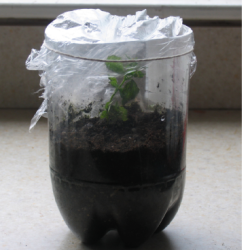Source Institutions
Source Institutions
Add to list Go to activity

In this activity, learners build a model of a self-sustaining habitat (growing grass and beans from seeds). They come to understand the natural conditions which promote plant, animal and human growth, and explore such questions as: What are the parts of a habitat? What are the habitat's sources of energy, food and water? How do the parts of a habitat work together? This activity can be found on pages 35-36 of the activity guide. [Activity is publicly available through a web crawler capture on Archive.org.]
- 1 to 2 hours
- 1 to 7 days
- $1 - $5 per group of students
- Ages 11 - adult
- Activity, Demonstration
- English
Quick Guide
Materials List (per group of students)
- 1 empty 2 liter soda bottle
- 1 cup of potting soil
- ¼ cup of gravel
- 5 bean seeds or 1 teaspoon of grass seeds
- 1 rubber band
- ½ cup of water
- Plastic wrap
- Worksheet – Small Habitats
- Observation Sheet
Subjects
- Earth and Space Science
-
Life Sciences
- Cells
-
Diversity of Life
- Plants
-
Ecology
- Ecosystems
-
Physical Sciences
-
Chemistry
- Chemistry of Life
-
Chemistry
-
The Nature of Science
-
The Scientific Process
- Formulating Explanations
-
The Scientific Process
Audience
To use this activity, learners need to:
- see
Learning styles supported:
- Involves hands-on or lab activities
Other
Access Rights:
- Free access
By:
Source Collection
- Science After School Consumer's Guide
Rights:
- All rights reserved, TERC, 2007
Funding Sources:
- NASA, NAS5-26555
- National Science Foundation, NSF 9730728
